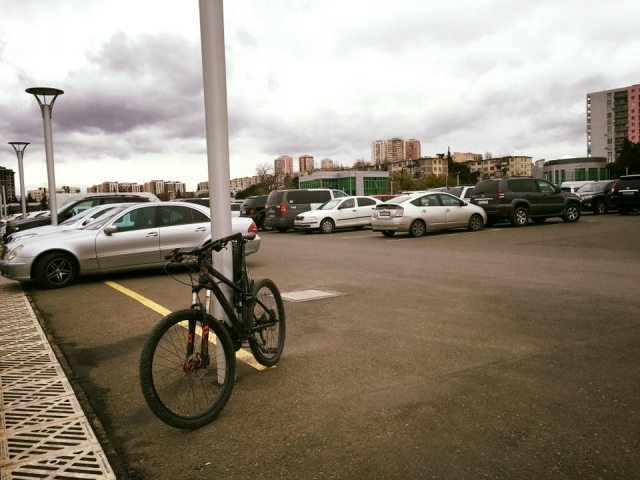Is the Bike a Mode of Transportation for Tbilisi?
TBILISI - There is a huge hindrance to developing a cycling infrastructure in Tbilisi. It is not a city naturally built for bicycles, the huge mountainous reliefs can’t create a suitable infrastructure and the narrow roads cannot handle both bicycles and cars.
So what prevents us from increasing the number of cyclists?
Well the abovementioned mountains and narrow roads are crucial at all levels of planning, and as such the bicycle is normally discarded. Geneva, Prague, Lisbon, San Francisco, Vancouver, and Bogota – the list goes on for cities built in a mountainous region like Tbilisi. However in these cities bicycles are getting more popular every year.
Also if we compare other cities with a mountainous relief like London Manchester and Cardiff and also countries like Holland, the bicycle usage reaches upwards of 30% each day. This is because the levels of bicycle innovation allow people to cycle on all types of road.
In Georgia the use of bicycles is steadily increasing every year, not only for recreational purposes in places like Batumi, which could be a model that could be used in Tbilisi.
The increasing number of permanent traffic jams, air pollution and road collisions has forced the government, businesses and local citizens to seek out an alternative means of transportation.
The bicycle has been considered as one of those. However there is no bicycle network in Tbilisi and currently only a few people use them. This is because of the lack of bicycle-friendly infrastructure, tracks and bicycle stations.
The use of the bicycle, the world-wide recognized healthiest transport is thought to be a necessary and useful at the same time.
Public space and parking spaces shrinking has become a part of daily life.
There is a strong argument to replace vehicles with bicycles in densely populated areas of the city. A network of cyclists is far cheaper than investing further in vehicle infrastructure. Bicycles are thought to make streets more attractive and a priority for cyclists should be recognized in the city center and older parts of the city. In research carried out in 2011 by French company “Systra” showed that most citizens used these areas every day.
In recent years the number of cyclists have increased not only for recreational purposes but also as a means of transportation.
On the last Friday of each month a cycling procession is carried out from Vake Park to Freedom Square and hundreds of amateur cyclists take part in it. The amateur cycling groups demand recognition and equality rights in traffic for both them and car-drivers.
Currently there is no cycling infrastructure in Tbilisi, this includes tracks, remarks and stations. You can only find these in recreational zones and parks at the moment.
Though the bicycle has become a means of transport in many cities, not only for recreation but also as a valid form of transportation to work and other destinations.
There are many people who want to ride their bikes in the open and use clean means of transport, though they cannot access data-bases, maps and road routines that provide information that makes them safe and comfortable.
According to Dutch experts who visited Tbilisi in 2014, it is possible to modify the Vazha-Pshavela Avenue and other avenues in the city to develop a link to the river Mtkvari that is separate from the transport network.
With the assistance of a former director and researcher from CRRC, Hans Gutbrod – who has 10 years cycling experience in Tbilisi, as part of the German International Cooperation (GIZ) framework, a first map was prepared, which mapped out the most commonly used routes and information about their complexity and any existing obstacles.
Nowadays it is possible to make a ramp for the disabled across the river route’s existing stairs according to this pilot map. At crossroads special traffic lights should be installed for bicycles or new colourful markers places on existing traffic lights.
Instead of an expensive infrastructure it is also possible to add special marks in the streets on the map for bicycles with a stencil or a new traffic sign. There is currently a project proposal for a 3km long bicycle track from Irish company ARUP waiting in the Tbilisi Mayor’s office.
It is also possible to open one-way streets bilaterally for cyclists to prohibit car parking in certain sections and restrict vehicle speed in dense urban areas.
It is important that the Tbilisi Mayor’s Office take bold steps to introduce the popularization of the bicycle as a means of transportation and take steps to develop the pilot project.
Drivers should also see that the infrastructure of cyclists is a part of the transport network and that the Mayor’s Office is set to encourage the movement of the bicycle and that of pedestrians.
Author: Gela Kvashilava
Photo: Nino Macharashvili
Gela Kvashilava is the founder the Partnership for Road Safety fund (http://safedrive.ge), advisory council member and regional consultant of the British organization Eastern Alliance for Safe and Sustainable Transport (www.easst.co.uk), expert at the EU TRACECA road safety project.












